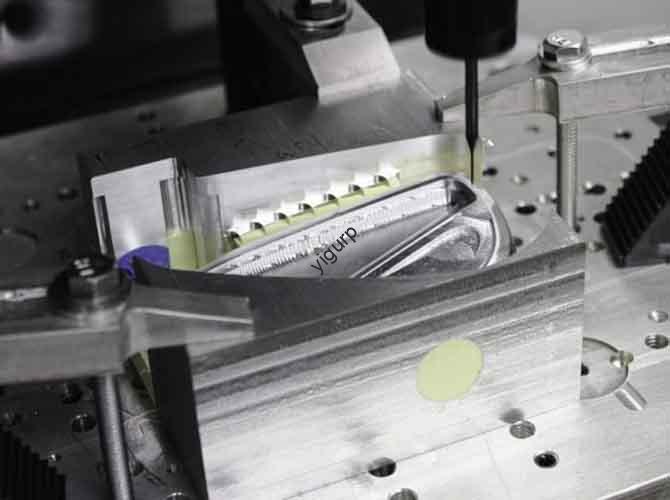CNC -Bearbeitung has become the backbone of precision manufacturing, but how do you consistently hit those tight tolerance targets? Whether you’re producing medical parts or aerospace components, CNC-Bearbeitungsgenauigkeit directly impacts product performance and customer trust. This article breaks down the critical factors affecting accuracy, Praktische Lösungen, and real-world benchmarks to help you optimize your process.
1. Core Factors Affecting CNC Machining Accuracy: A Comparative Table
Not all accuracy issues stem from the same source. Below is a side-by-side look at the top 6 Faktoren, their impact, and quick fixes:
| Faktor | Auswirkungen auf die Genauigkeit | Quick Optimization Tips |
|---|---|---|
| Machine Quality | Hoch (30-40% of errors) | Choose machines with rigid cast iron frames |
| Werkzeugqualität | Hoch (25-30% of errors) | Verwenden Sie Carbid -Werkzeuge; replace after 50 Nutzungszeiten |
| Temperaturregelung | Medium (15-20% of errors) | Maintain shop temp at 20-22°C (± 1 ° C) |
| Programming Accuracy | Medium (10-15% of errors) | Test tool paths with simulation software |
| Bearbeitungsgeschwindigkeit | Niedrig bis mittel (5-10% of errors) | Reduce speed by 10% for tolerances <0.01mm |
| Fixture Accuracy | Medium (15-20% of errors) | Use hydraulic clamps for stable clamping force |
2. Let’s Dive Deeper: Critical Factors Explained
Machine Quality: The Foundation of Precision
A CNC machine is only as accurate as its components. Einsatz hochpräziser Maschinen:
- Rigid structures: Cast iron frames reduce vibration during cutting.
- High-quality ball screws: Minimize backlash (ideal for tolerances down to 0.001mm).
- Precision linear guides: Ensure smooth, consistent movement of the spindle.
Zum Beispiel, a mid-range CNC mill might achieve 0.01mm accuracy, while a high-end model (like those used in semiconductor manufacturing) can hit 0.001mm—10 times more precise.
Werkzeugqualität: Don’t Overlook the Cutting Edge
Imagine using a dull pencil to draw a straight line—tools work the same way.
- Geometrische Genauigkeit: A tool with uneven edges will leave rough surfaces and miss tolerance.
- Wear state: Nach 8 hours of continuous cutting, a high-speed steel tool can lose up to 0.005mm of its edge—enough to ruin a part requiring 0.003mm accuracy.
Lösung: Verwendencoated carbide tools (Z.B., TiAlN-Beschichtung) to extend life and check tool wear with a micrometer every 2 Std..
Temperaturregelung: The Hidden Accuracy Killer
Why do bakeries keep ovens at a fixed temperature? Because materials expand and contract with heat—same for CNC machining.
- A 5°C temperature rise can cause a 1-meter aluminum workpiece to expand by 0.06mm (more than the typical 0.01mm tolerance!).
- Even spindle heat matters: A hot spindle can shift by 0.002mm mid-machining.
Fix: Install HVAC systems with precise controls and usecoolant systems to keep tools and workpieces at a steady temp.
3. Real-World Accuracy Benchmarks: What’s Achievable?
How do these factors translate to actual results? Here’s a breakdown of typical accuracy levels for different industries:
| Industrie | Erforderliche Genauigkeit | Common CNC Setup |
|---|---|---|
| Automobil | 0.05-0.1mm | Mid-range CNC lathe + HSS -Werkzeuge |
| Medizinprodukte | 0.005-0.01mm | High-precision mill + Carbid -Werkzeuge + temp control |
| Luft- und Raumfahrt | 0.001-0.005mm | Ultra-precision machine + ceramic tools + vibration dampening |
4. Die Sicht von Yigu Technology auf die Genauigkeit der CNC-Bearbeitung
Bei Yigu Technology, Wir glaubenaccuracy is not just a specification—it’s a process. Our CNC solutions combine rigid machine designs with intelligent temperature monitoring to reduce errors by up to 30%. We often advise clients to start with a “accuracy audit”: test their current process against the factors in this article, then prioritize fixes (Z.B., upgrading tools before buying a new machine). Für die meisten Hersteller, klein, targeted changes (like better fixture clamping) yield faster ROI than full overhauls.
FAQ
- Q: Can I achieve 0.001mm accuracy with a standard CNC machine?A: NEIN. Standard machines typically top out at 0.01mm. Ultra-precision machines (with specialized components) are needed for 0.001mm tolerances.
- Q: How often should I calibrate my CNC machine to maintain accuracy?A: Für hochvolumige Produktion, calibrate every 3 Monate. Für geringe Lautstärke, precision work, calibrate monthly.
- Q: Does faster machining always mean lower accuracy?A: Nicht immer. Some modern machines use “high-speed precision” technology (Z.B., adaptive feed rates) to maintain accuracy at faster speeds. Test with your specific part and material first.
